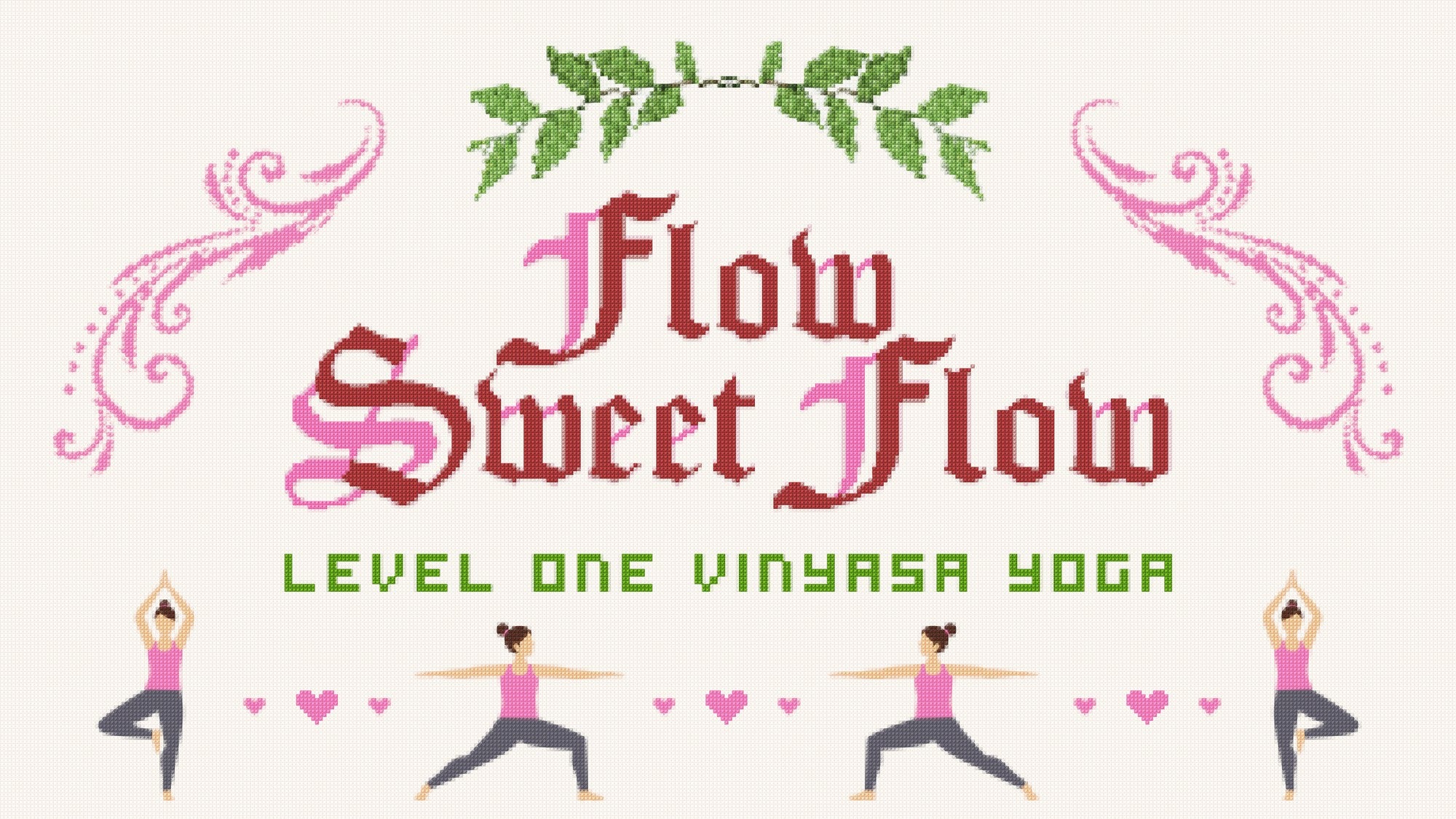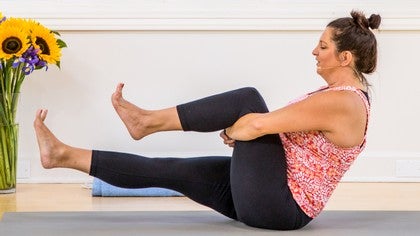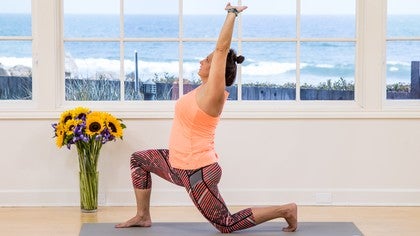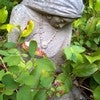Description
About This Video
Transcript
Read Full Transcript
Namaste, welcome. So this practice is designed to assist you with your vinyasa classes. So we'll talk about the core body, how to activate the core body, and postures. It's also a practice you can do at any time of the day. So come along with me.
We'll start out from sitting with the legs extended in staff pose. So in staff pose, I want you to feel like you get really tall. I want you to feel like your shoulders open up. The collarbones get wide. And then the hands move back a little bit more behind you.
Lean on back into the arms, lift the chest, and just observe what it feels like to lift a leg. Just to get a little sensation of what that is. Lift the other leg. And bring both of the legs down. We'll do that one more time.
So as you lift the right leg, you're spreading the toes and you're just letting yourself sense the weight of the leg and the effort that it takes to lift it. Make sure your body's kicked back just a little bit like I have mine here. Left leg comes up, and that comes back down. Now bring yourself completely upright. Once you're completely upright in your staff pose, try it one more time, and just notice the difference.
More requirement of the leg, less requirement of the core body. Do the left leg, and lowering it down. So this action of releasing back actually gives you more access to the core body. So try it one more time. Hands go back, lean on back, lift the right leg.
Notice now it's not only the leg, but also the core body that's assisting in the lift. And let's do so on the left leg as well. And then bring yourself back up. Coming to staff pose, we'll start with the right leg. So I'm going to bend my right leg.
So bend your right leg, bring it to the body, to a comfortable place. Wrap your arms around it so your arms are helping. Now you may notice here that the leg doesn't have to do much and the core body doesn't have to do much. But we're going to activate both, even though it's being assisted. So I'm gonna ask you to narrow your hip points, draw your belly in between the hip points.
These are your hip points. And then bring that whole energy up just a little bit. So there's a switch that happens and you feel the core body kinda wake up. And then with the leg, I want you to push on the pad of the foot like you're pushing on the gas pedal. And then feel the muscles dense into the bone of that leg that you're supporting.
You do those both at the same time. So the hip points narrow, and there's that lift. The muscles deepen, and there's that subtle press to the pad of the foot. And then let the right leg go. Let's do the other leg, bending the left leg.
Hold it in nice and close to your body. First notice what it feels like when the leg doesn't do much, core body doesn't do much, and then begin to activate them. So we'll activate the hip points narrowing, feeling like everything's drawing up, sort of like tightening a bootstrap, and then that sense of the muscles deepening into the bone, everything drawing in and up, in and up, in and up, muscles deepening, pressing into the pad of the foot. So there's a lot of effort going on, but there's still a sense of support in the leg and support in the core body. And then let that leg go back down.
Back to staff. So now we're gonna do it with both legs lifted. This is really fun. So you're gonna lean back. Remember this is a key.
That lean back allows you to access things more deeply. I'm gonna wrap around both legs, but I'm still gonna activate these things. So you can kinda think of this as the bum balance. So I'm balancing on my bum. If you have a really skinny rump, you're kind of in trouble.
It's more balance if you have kind of a badonkadonk, you're good. Alright, we got some good foundation down there, girls. Alright, so from here, I'm gonna narrow the hip points. Draw the belly up, and then I'm gonna activate the muscles around the bones. And then a nice lift, gonna take a few breaths.
It's a little interesting to breathe when you're allowing the core body to engage, but just keep it up. You might even feel, what if I straighten my legs a little? But I maintain all of this interesting effort, this quiet effort, this quiet attention. And then lowering the legs back down. Lifting up in the chest, here we are again in our staff pose.
In staff pose, just let the legs quiet, let the core quiet. Be here for a breath 'cause it's about to get rocking fun. Start with the right leg again. The left leg's gonna be straight, holding on only to the right leg. I'm narrowing the hip points, engaging that core body, that quiet engagement.
I'm engaging the muscle into the bone to the legs, press into that pad. Here we go. And then to activate the left side core body, I'm gonna lean back and let the leg float. Doesn't have to float high, just has to float a little, but everything is still in attention. Particularly, the muscles are deepening around the bones of this lifted leg, and here I go.
Taking a breath. Keep breathing. Here you go, oh I know the leg is starting to talk. And then you slowly release it down, slowly extend that right leg, lean yourself back, and lift the chest. This little lean back and lift of the chest, it's a nice way to kind of relax that core body because you're stretching it out, so it's not gonna engage when it's feeling that stretch, it's gonna relax more.
Draw both legs in, hug both legs. Engage the core, engage the legs. Keep that sense of work as you straighten the legs any amount. Balance on that bum. Boy I tell you, 250 things are going on in the body right now just to keep you in this shape.
That's not only good for your body, it's super great for your brain. Down you go, all the way back to our illustrious staff pose. Left leg, draw your left leg in. Engage that quietness in the core so that it's firm, there's integrity, there's attention. Deepen the muscle into the bones of the leg, press through the pad of the foot.
Lean back, that lean back is gonna assist in joining together the strength of the leg with the strength of the core body. Particularly, that straight lifted leg, keep the muscles deepening into the bone, keep deepening into the chest, and breathe. Nice and even. It gets to feeling a little bit like, "Hello, I'm working." Slowly you can let that move down. Straighten that left leg.
Lift up, lean back, stretch out the core belly just a little bit. Bring yourself back up, one more tandem. Tandem leg work, so engage the belly, holding both legs. Engage the muscles into the bones of the legs and straighten the legs any amount that feels comfortable to you. And then down you go.
Straighten the legs. So this next one is sort of hands-free. However, if that was challenging for you or it felt like that just puts you in the perfect place with the practice right now, then you just go ahead and hold the leg instead of floating the leg. You'll see what I mean in just a second. So I'm gonna lean back again.
Remember that leaning back helps to bring together the power of the legs with the power of the core. So lean on back, bend your legs, and you're gonna separate the legs. So one leg is gonna be a little lower than the other. For me, my right leg is lower than my left. I'm keeping my hands on the ground because it feels more steady.
If you really wanna get the gusto, bring the arms forward. It's pretty challenging, either one is fine. And then lower back down to that staff. Lift up into the chest, and then lean back, and reach up and open the chest to help lengthen out those muscles in the core. Oh boy, we got another side ready.
Coming back to staff, bending the legs. Lean back, I'm gonna use my arms for support. This time, my left leg's gonna be lower than my right. I'm feeling the muscles deepening in the bone, I'm engaging my abdominals, there's a definite lift, no bearing down, you're drawing the muscles in and up. And there you go to staff.
Open the chest. Lean back and open the front body. Then come back to staff pose. So from this staff pose, lean back again and bring the soles of the feet together. This is called Cobbler's pose, and in this pose, all I want you to do is just fold forward for a moment.
So what are we doing here? We're stretching out the back body. It just did a lot of work for us, too. When you work the core body and the back body together, they stabilize one another, which is wonderful. But remember, the back body's still doing some work.
So this helps to relax the back body. Coming on back up. Extending both legs out again, and then bend your right leg and lay it out to the side. In this posture, we're gonna turn in the direction of the straight leg while we feel like we're standing up. So there's a sense of lift in the spine.
And then I'll turn a little bit, you can turn your body a little bit and just lay yourself over that extended leg. The sensations that you may experience will be in the back of the straight leg. It's not to create an overabundance of sensation, but to feel the stretch in the back and the stretch in the back of the leg. And then as you bring yourself up, you can kinda walk the hands up to bring yourself up. Straighten that bent leg, and let's bend the left leg, same thing.
There's the lift, there's the twist, and as it feels appropriate, there's the release over. So there's a long sense really of unwinding. All the previous work that we just did. And then you fold fully over that straight leg. Folding over the straight leg.
You feel the sensation in the back of the leg. You feel the sensation in the back body. Easing your way up. Straightening back to your dandasana. Now fold the legs, and let's roll forward.
As we come to hands and knees, we'll work a little bit with a very deep muscle in the core body called the psoas. So the right leg steps forward, slides forward I should say, and if you feel like you're falling forever towards your backside, you could use your blanket and tuck it under just a little bit, and then just fold over that front leg. You will immediately feel things. You'll probably feel something under your right rump. Deep in the right rump.
You might feel something along this long line of the straight leg. This is a modified pigeon pose, super great for your pelvis. And you know, the core body is attached to the pelvis. It's got a lot, it's all fitting together perfectly, like a beautiful puzzle. So the health and the well-being of the pelvis encourages the health and the well-being of the core.
Take your hands down, place them on the mat, and slowly ease your way up. This shouldn't compromise your back in any way. And then the back leg simply bends. And as it bends, you reach back, just take a hold of it. Sometimes, maybe it's easier to take a hold of your tight.
You could do that, too. As you're holding the leg, or maybe you're holding the foot, feel like you're still sitting upright, but the sensation really is a sensation like the leg is yawning. It feels like, "Ahh." So you don't wanna go beyond that sensation. And then you let that leg go, you keep the toes curling under, and straighten the leg until the knee comes off the ground so you've got the ball of the foot pressing, and the knee off the ground, you get this nice extension through the leg, and then just relax the leg and bring yourself forward again. Very beautiful, very short little sequence that will help every aspect of your life, so great.
In the car for a long time, sitting at the desk for a long time, you overdid it in a hike, you name it. It's a great little sequence for the body. To switch sides, the hands will go underneath you. Back foot, the toes will curl under. Bring yourself right to hands and knees.
And then you'll slide the second leg forward. The left leg comes forward. Again, if you feel like you're falling to your left side, you can support the left hip. Make sure the knee's comfortable, folding forward. You'll feel a stretching sensation deep in your left rump and possibly a lengthening stretching sensation in the front of the extended leg.
Couple more breaths here. You may be noticing, this is more sensation here or less sensation. We all have differing experiences from side to side. And then up, up, up, walking the hands back, bringing the body more upright, feeling like you're lengthening up into the crown of the head again. You'll bend the back leg and just grab a hold of it.
Now I've grabbed my right leg or right foot with my right hand. It's always the same side that's grabbing. And then that feeling of sitting up is gauged. I want this to feel like that yawn, like that "Ahh, it feels so good" feeling. You have to go in there and feel like, "Is that what's happening?" If it's more intense than that, let up a little bit.
If it's less intense than that, then press that back leg down and push your leg into your hand. Then you let the leg go, the toes curl under. The knee lifts off the ground, toes are still curled under there. Nice extension to that back leg. And then relaxing fully and folding forward.
Relaxing the back of the neck. Plant the hands down, draw the body up, slide the leg back, coming to that downward dog. Feeling that nice downward dog. Go ahead and bend your knees a little bit, and maybe sway the hips a little bit, do that walking the cat. And then lower yourself down.
Then sit back, sit in a comfortable way 'cause I'd like to show you how to use this blanket for what we're gonna do next. Now some of you might have towels; a towel works, too. I'm gonna use a blanket, and I'm gonna open it up to that shape, and then roll it into a tube. Rolling it all the way up so it looks like that. And I'm gonna place it to the side.
So blanket's rolled up, place it to the side. Or towel; towels work, too. And then let's come to lie down on our back. Make sure you can reach your blanket, your little friend. So on your back, your legs are bent.
Take a couple of breaths here, just to let the body grow quiet. It just learned a lot, right? We learned a lot about the core body, we connected what the body understands with what our mind now understands. We'll investigate a little bit more. But first, we're gonna press the feet down, lift your pelvis, and slide the blanket underneath your pelvis.
Now there's a sweet spot. You'll have to find your sweet spot. For me, it's right at the center of the bone at the back of the pelvis called the sacrum. Once there, investigate, extending a leg up. What that feels like.
Extending the other leg up. And then let's take both legs up. And you might wiggle a little bit just to feel what that feels like. There's two directions the legs are gonna take. The first time we do this, the right leg's gonna move towards you a little bit, and the left leg's gonna move away from you a little bit.
The left leg's gonna have a lot more freedom, so just keep letting it move down to whatever level feels good. You can feel the engagement of the belly. And then you can bring that one back up until they meet together right above you. And then switch that. So I'm gonna bring the left leg a little closer to me.
That creates the counterbalance that we did when we were leaning back. And then I'm gonna let that right leg release down. I'm not really interested in taking it all the way down to the ground because I'm working on strengthening, not creating more flexibility. So let it hover, and that will help engage more, and then bring both the legs back up together. Again, so the right leg comes towards me a little bit as the left leg releases down.
It doesn't release all the way to the ground. The muscles are deepening into the bones, the hip points are narrowing, the belly is very consciously drawing in and up. That comes back up, up comes that left leg, feet are together, left leg moves a little towards you while the right leg releases out. Both legs stay very straight. Squeeze the muscles into the bones.
Hover that leg, you can do it. Draw the belly in and up. Our bellies have so much power. Go all the way back up until both legs are together again. Now leave the right leg where it is.
Let's take the left foot to the floor with the leg bent. This is a very fun practice and very engaging to the body. We'll take the right leg a little more to the midline, so it crosses a tiny bit over, and then wiggle the bent leg, the left foot, over a little more to the midline. That'll help things. And then very simply press into the left foot and lift your pelvis any amount.
Take a breath. Lower back down. We'll do one more, remembering to engage the muscles around the leg, draw the hip points in, bring the belly in and up. When you're ready, lift and lower back down. Left leg joins the right leg, right leg goes to the floor.
Left leg a little across the midline, right leg wiggles a little over, press the right foot down, engage the abdominals so they draw in and up, firm the muscles in both legs around the bone, and lift. It's a small but mighty lift, so don't be discouraged if you don't feel like you're lifting very high. A lot is happening. Let's do that one more time. Foot presses down, up you go.
And lower yourself down. Both legs join one another. Now we're gonna engage the arms in this next part. It'll seem familiar. I'd like to bring the left leg, so bring your left leg towards you, take your arms overhead.
I want you to feel the difference here when the arms are also extended. Start to drop that right leg. Remember you're not gonna drop it all the way to the ground. You're engaging the abdominals, drawing them in and up. Arms are overhead.
Bring it just to that parallel place where it seems like it's hovering above the floor, and then back it comes. Feet come together, right leg draws a little towards you, and left leg releases away, and as it releases away, you're engaging the muscles of the legs into the bones of the legs, engaging the abdominals in and up. Hover that leg, and then up you come. Both legs together. Now this will be the third time we've done this, but watch what happens when you put your hands and just rest them on your belly.
Right leg comes a little closer, left leg releases. Feel the difference. So the abdominals are contracting, and it's a much steadier experience bringing that left leg up, joining the legs. Left leg comes forward, right leg releases. So at their resting state, those abdominal muscles, they're ready to engage.
That leg comes up, right leg comes up, both legs are joined. When our arms are over our head, we're extending those muscles, and they have less of an ability to create core strength for us, so it's something to take note of in some of your postures, that if it's like, "Wow, I just don't feel as strong here." If you're really extending through the core, everything's lengthening and the muscle's ability to fully contract is changed. It's not a bad thing, it's just change so keep that in mind. So both legs bend now. Place both feet on the floor.
Press both feet down into the floor, and lift the pelvis any amount. Lower yourself back down. Draw the legs into your chest. Feet come back to the floor. You inhale here, there's so much room to inhale when you're moving in a shape where there's lots of space for the lungs.
And then the pelvis comes down as we exhale, and the exhale's so much easier because the legs are closing off the space for the lungs. So I need space, so I inhale as the legs come down, and the pelvis rises, and I exhale, I don't need as much space, so it's a perfect time to round them back. Let's do that one more time. Need more room to inhale, so as I inhale, the legs are moving away, lots of space. I'm exhaling, I don't need extra space because the lungs are getting smaller, perfect time to bring the legs in.
Lowering the feet down now. Press into the floor, lift the pelvis and let's slide that roll back out of the way. Lower yourself down. Take a couple of moments to let gravity find the pelvic bones. The legs are relaxing towards one another.
The lower back is relaxing. Everything's sort of like, "Ah, here's the ground again." The work's over. So as you roll to the side, you're doing it very consciously. Your body's done a lot of interesting work for you. Now press yourself up.
You're gonna use this blanket that just helped us so much to sit on. Elevation of the pelvis gives a lot of relief to the core body after a vigorous practice. So you come to sitting, and then let yourself be held by gravity, that means you're sitting and relaxing, the lower body descends, the upper body remains elevated, you can close your eyes, there's a feeling of equanimity in the body when we use our core body in a harmonious way. So feel that balance. Notice that the breath is freer, there's more space and ease for the breath.
And then your palms come together, your eyes peep open. It was super fun, please use this to help you with your further practices. Peace out. Namaste.
Flow Sweet Flow: Laura Tyree
Comments
You need to be a subscriber to post a comment.
Please Log In or Create an Account to start your free trial.






















